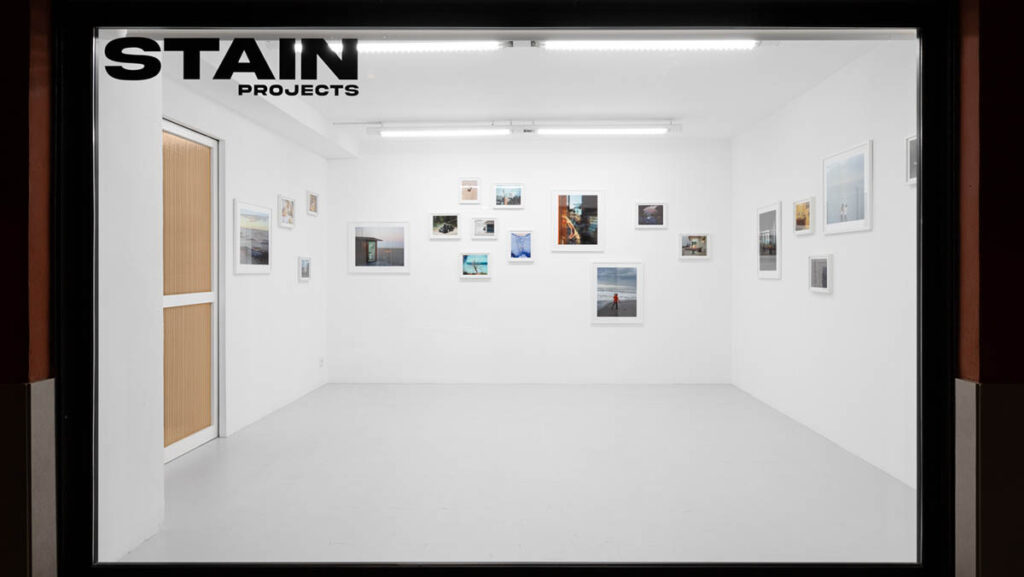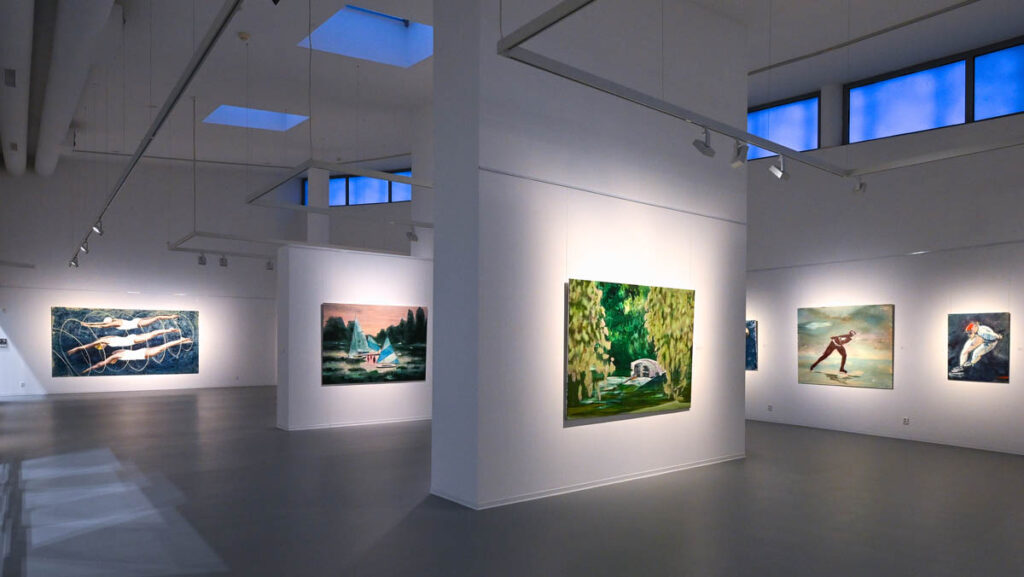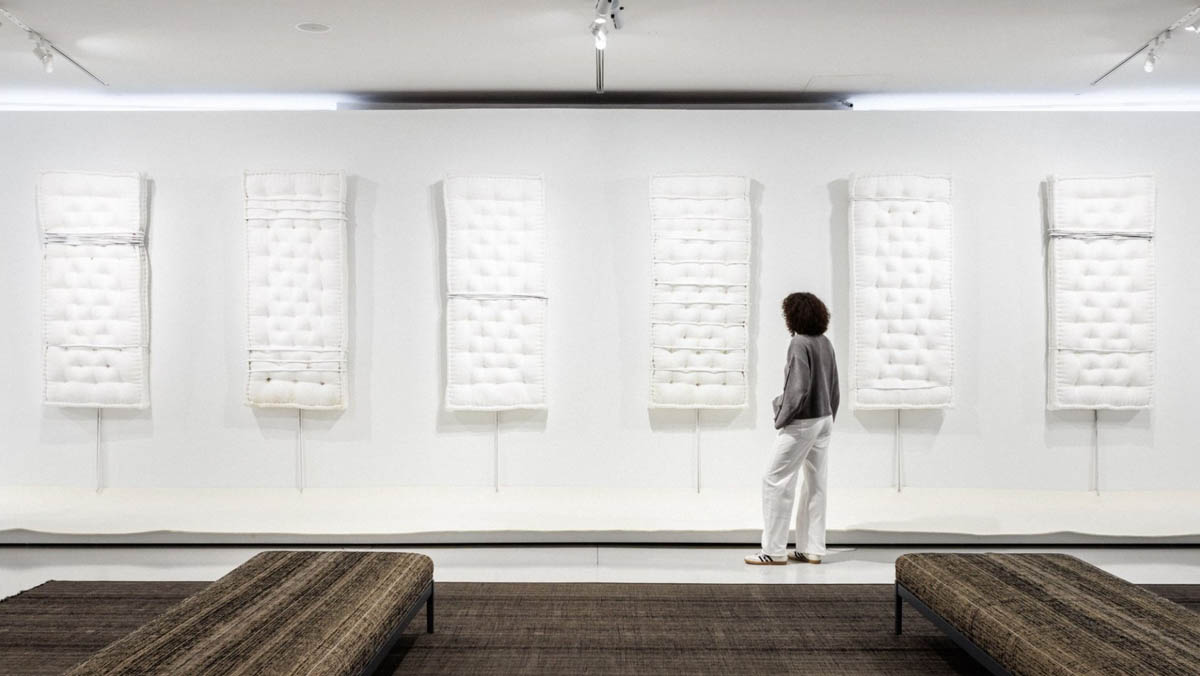
Until January 20, 2025, the Bourse de Commerce in Paris hosts a rich ensemble of works: over 250 pieces from the Pinault Collection and loans from various institutions, including the Castello di Rivoli and the CRT Foundation in Turin.
The exhibition immediately reveals its essence in the Rotunda. A vast assembly of artworks fit together like pieces of a puzzle. Despite their diverse materials, mediums, and colors, these works improbably coexist in perfect harmony, expanding like an oil slick.
They seem alive, some even breathing, eager to promenade through the streets of Paris.
This group of thirty works offers a preview of the thirteen featured artists before delving deeper into each in dedicated spaces. At the heart of the building, this collection acts as a pulsating core. Along the 24 impeccably polished showcases in the Passage lies invaluable documentation: the catalogue of the Arte Povera exhibition at Galleria de’ Foscherari in Bologna in 1968, the first edition of Carla Lonzi’s Autoritratto, and the monumental 1967 issue of Flash Art featuring Germano Celant’s “manifesto,” Arte Povera. Notes for a Guerrilla, among others.

The journey begins underground, with Gilberto Zorio in the Foyer. Zorio, the youngest and most international of the group (he married Marisa and Mario Merz’s daughter), invites visitors into Microfoni (1968). From the ceiling hang a series of microphones, which visitors are encouraged to grasp, dematerializing them with their voices, sounds, and songs. The result is an ephemeral performance: pure social energy that sculpts the surrounding space. Iconic pieces like Arco voltaico (1968) and Tenda (1967) introduce us to key themes of Arte Povera—alchemy and the instability of materials.
In the Studio, we meet Emilio Prini, one of the movement’s most complex and enigmatic figures. Invited by Celant, he debuted in 1967 at the Arte povera–Im Spazio exhibition at Galleria La Bertesca in Genoa without having ever exhibited before.
In his dedicated space, fluorescent tubes positioned at room corners capture both our eyes and ears. Blinking white neon lights, aided by audio signals, emphasize and materialize the environment. Here, the „void“ becomes tangible, and we become acutely aware of our presence within it.
Ascending the stairs, we return to the Rotunda to explore Jannis Kounellis, the artist of fire—a primordial and mystical element. His relationship with fire begins with Senza Titolo (Margherita di Fuoco) (1967), representing the tension between industrial society and the elemental forces of nature. Gas burners behind a metal corolla generate real flames, like fiery pistils, igniting and extinguishing in a perpetual cycle of destruction and regeneration.
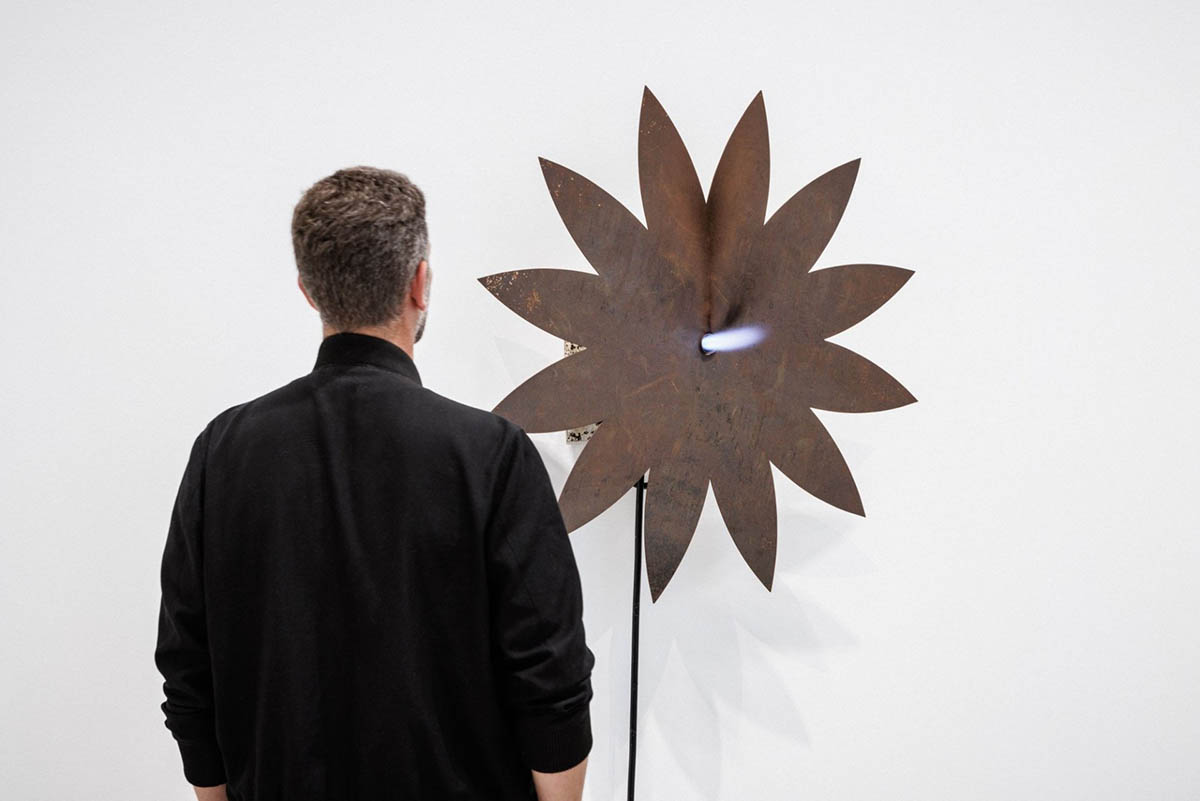
Marisa Merz shares a large gallery with her husband Mario, but their artistic paths remain distinct and deeply personal, nourished by mutual support. Marisa’s space exudes a gentler, familial atmosphere, shaped by the feminine sphere. Her works—delicate yet striking—convey a sense of vulnerability. Intimate potential emerges in her early performances with Mario at the 1970 Galleria L’Attico show in Rome, or in her refined copper-laminate works like Scarpette or Parete di rame, painstakingly crafted with care and precision.
Mario Merz dominates the other half of the room, filling it from floor to ceiling. Above us, the Fibonacci sequence glows in neon, originating from a large alligator sculpture (Fibonacci Alligator, 1972). This sequence, integral to Merz’s exploration of natural order and universal harmony, interacts with the primal energy of the alligator—a duality symbolizing the interplay between structure and chaos.
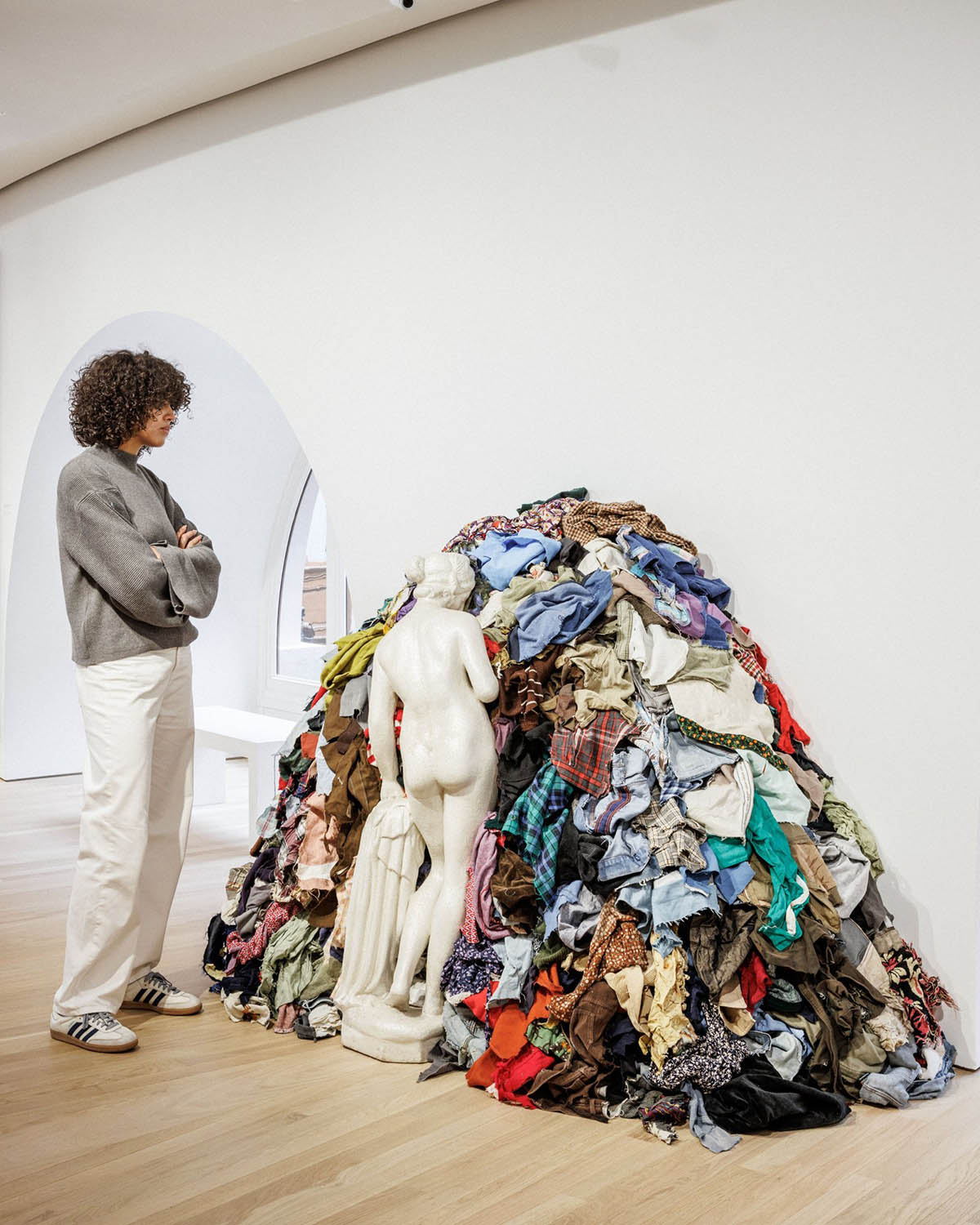
Climbing to Gallery 3, a heap of clothes announces Michelangelo Pistoletto’s presence. Inside, we find his iconic Quadri Specchianti (Mirror Paintings), where he replaces traditional canvases with reflective surfaces, constantly transforming based on who gazes into them. The room also features his Venere degli Stracci (Venus of the Rags), sadly (?) infamous for its recent destruction in Naples, where a larger version was set on fire in Piazza del Plebiscito.
On the top floor, we encounter a series of unique universes. In Alighiero Boetti’s gallery, the iconic Catasta embodies the balance between “will” and “limits,” while his maps quietly reflect the ever-changing geopolitical shifts of our world.
Giovanni Anselmo explores energy and transience, as seen in Torsione and Insalata, where the transformation of organic and inorganic elements triggers a meditation on impermanence.

Giuseppe Penone’s gallery feels alive, breathing with a vegetative essence. His early interventions, such as Continuerà a crescere tranne che in quel punto (It Will Continue to Grow Except at That Point), reshape natural growth through gentle yet irreversible actions, like imprinting his hand on a tree trunk with bronze or zinc filaments.
The concept of transience physically marks the space in Pino Pascali’s work, as this time 32 square meters of sea—first exhibited in 1967 at Palazzo Trinci in Foligno—spreads out like two long stretches of sky, shifting from turquoise, like the sea at the shore, to a deeper blue, akin to the vastness of open waters. „You cannot step into the same river twice,“ the Greek philosopher Heraclitus once said, expressing his vision of reality as a constant flow, always in transformation. This perspective, shared by the artists of Arte Povera, helps us understand the essence of their work. (The second time I visited the exhibition, I saw a child blowing on the water’s surface, causing a small spill from the basin. I think Pino Pascali would have enjoyed that.)
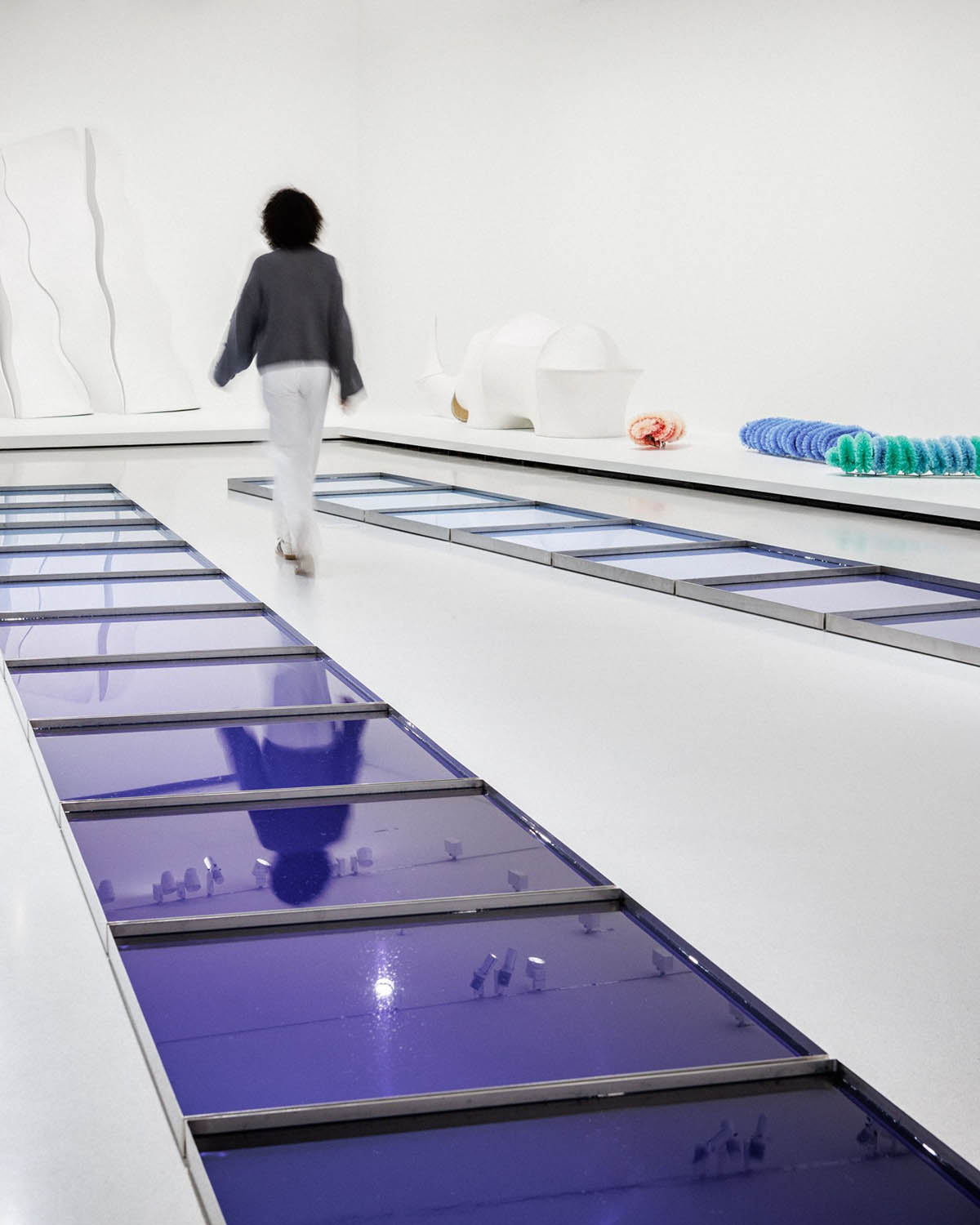
Finally, Pier Paolo Calzolari’s gallery envelops us in a cocoon of white felt. Works like Oroscopo come progetto della mia vita (Horoscope as Project of My Life) or Scala 2000 lunghi anni lontano da casa (2000 Long Years Away from Home) engage with alchemical processes, continuing the transformation of materials begun with the ice-covered mattresses at the exhibition’s entrance.
My visit concludes with Giulio Paolini, the 2022 recipient of the prestigious Praemium Imperiale for painting, awarded by the Japan Art Association.
In his gallery, Paolini presents visitors with an orderly theatrical scene and a white A4 sheet pinned to the wall with two golden tacks. On the sheet, an author’s note guides the viewer through the scenario: Disegno Geometrico, Paolini’s first complete work, rests on an easel in front of what he wishes to define as a „painting.“ In reality, it is more a gallery of paintings, featuring a selection of his works created from 1960 onward. The artwork’s perspective is marked by red tape on the floor, a clear homage to perspective and to Giorgio de Chirico, who oversees the room from the left, and to Rousseau, who announces the scene from above—an homage to Western art and culture.
After this long journey, we ask ourselves: is this Arte Povera truly „poor“?
In some ways, absolutely. It is poor in materials: wood, earth, plants, and stones are not expensive—they can even be found for free (a walk in the woods will suffice). But these materials carry a vital energy, a transformative power that turns every work into a tangible experience. Looking at the ice on the mattresses sends shivers down your spine. The ice grows, and we feel time slipping by, aware of the inevitable flow of existence.
Arte Povera is as conceptual as it is material, thriving on an invisible, primordial force it seeks to share with us. Like us, it lives, transforms, embodies fragility, and celebrates metamorphosis. Its rejection of expensive materials and complex techniques resists the glorification of luxury or the ephemeral, urging a return to a natural connection. Artists place themselves on equal footing with the materials they use, establishing a relationship of mutual respect and parity. The material becomes a co-creator of the artwork, dismantling all forms of hierarchy or dominance.
It’s a collaboration, a dialogue, a process of listening—to the world, to others, to ourselves. It is an acknowledgment of presence, both ours and that of others. It is recognition of our humanity. And now, all that’s left is to live.
Exhibition: Arte Povera at Bourse de Commerce — Pinault Collection
Exhibition Duration: until January 20, 2025
Margherita Animelli lives and works between Bergamo and Paris. She studied painting at the Accademia di Belle Arti Giacomo Carrara, graduating with a thesis exploring the motifs and meanings of destruction in art history. As a freelancer, she specializes in cultural communication and serves as the curator of Archivio Mariella Bettineschi @marrrgh.




